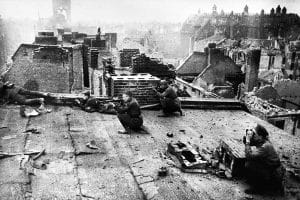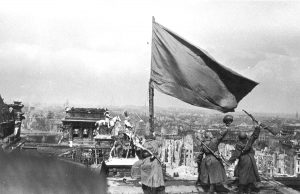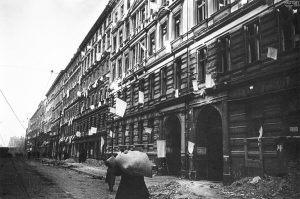As Soviet forces moved throughout the city from district to district, breaking through defensive lines and clambering through the tenements and courtyards, the unit commanders were faced with the task of moving behind their troops and struggling to keep up with the pace of the crooked advance.
The previous day, Berlin Defence Area Commandant, General Weidling, had been forced to abandon his headquarters on Hohenzollerndamm and move to a new command post in the cellars of the Bendlerblock army buildings, south of the Tiergarten. Shortly afterwards he would have to move again to the cramped Army Signals bunker outside when a shell crashed through the floors above, causing a heavy safe to smash down into the cellar and kill a young Bund-Deutscher-Mädel girl working there as a volunteer nurse.
Hitler Youth leader, Artur Axmann would also move his headquarters from Kaiserdamm 86 in the west to Wilhelmstrasse 64 in Defence Sector Z, where he could be closer to the Nazi leader.
After taking Tempelhof airport on April 26th, Vasily Chuikov – head of the Soviet 8th Guards Army – moved his field headquarters from Johannisthal Airfield in south-eastern Berlin to a traditional Berlin apartment on Schulenburgring 2 in Tempelhof on April 27th. Previously occupied by a lady named Anni Goebbels – no relation to the Nazi party Propaganda Minister of the same name.
He would remain here until for the rest of the battle for the city – and importantly use this apartment to accept the surrender of Berlin on May 2nd.
Chuikov decided to dedicate the next 24hrs to resting his troops and consolidating the territory already taken, in preparation for crossing the Landwehr Canal. The 28th Guards Rifle Corps having established a firm base for launching the forthcoming operation by securing the areas around Nollendorfplatz and Lützowplatz – although these two squares would remain in German hands until the end of the battle of Berlin.
Chuikov’s troops would soon be tasked with attacking the area to the south of the Tiergarten as far as the East-West Axis, including the Potsdamer Platz and Anhalter Bahnhof leading to the Reich Chancellery.

Having made serious headway into the districts that once surrounded Berlin’s royal quarter – the historic central Mitte district – Red Army troops were now probing the heart of the capital.
On April 27th, Soviet tanks fighting in the western districts of the city managed to break through the Berlin Zoo perimeter wall and were able to fire on the nearby Zoo Flak tower, although with little result. One of three mammoth defensive fortifications around the city, this tower would continue to plague the Red Army drive into the city centre until the end of the battle of Berlin.
SS Major General Mohnke, tasked with defending the central district, would record on April 27th that Soviet tanks had even managed to push as far as Wilhelmstrasse before being destroyed. Two captured Czech-made 38T tanks, covered in swastikas, were sent forward by the Soviets at the front of a column aiming to reach the Chancellery. Although as the group moved through German lines the ruse was spotted and the tanks engaged by a Sturmgeschütz III assault gun manned by SS Nordland men.
Mohnke would thus move 105mm howitzers into Gendarmenmarkt, Pariser Platz, and Leipziger Strasse to cover the perimeter of his zone – although the gunners only had 12 rounds per gun and were ordered to fight on as infantry when they had exhausted their supply.
The general plan for the Soviet advance into Sector Z – the central government quarter – for the final confrontation would involve moving troops along four main axes in the city:
- From the east, along Frankfurter Allee to Alexanderplatz
- From the south, along Sonnenalle to Belle-Alliance-Platz
- From the west, along Potsdamer Straße to Potsdamer Platz
- From the north, along Müllerstrasse to the S-bahn ring and towards the Reichstag
The demarcation line at Anhalter Bahnhof between the forces of Georgy Zhukov’s 1st Belorussian Front and the 1st Ukrainian Front of Ivan Konev’s forces would still provide a modicum of contest between to two Soviet Marshals – as Konev’s troops leapfrogged their way around obstacles in the south and south west of the city, and Zhukov’s force pushed east and against the S-bahn ring in the north.
On April 27th, it still looked like Konev’s forces in the south might manage to push through the Tiergarten central park and take the final prize themselves – the Reichstag building.

In the south-east of the city, two under-strength German divisions – the SS Nordland and Müncheberg Panzer Division – were now facing five Soviet armies and being forced back into the centre.
In the north west, the Soviet 7th Guards Tank Corp had orders to reach the banks of the River Spree at Ruhleben and link up with the rest of the 1st Belorussian Front across the water but were ambling along at a slow pace – the unit commanders confused by the maze of rubble filled streets with limited map reading skills, broken radios, and compasses that seemed to be suffering from the large amount of metal in the area from the fighting.
By April 27th, the Zhukov’s forces had bypassed the Beusselstrasse S-bahn station strongpoint in the north and were pushing through the Moabit district, although the heavily built up nature of the area meant that progress was slow and costly.
Reportedly among the defenders of the Moabit district in April 1945 were men of General Andrei Vlassov’s White Russian units. Vlassov had been a Red Army general decorated with the Order of the Red Banner for his efforts in the defence of Moscow. After being captured by the Nazis during the siege of Leningrad, he defected and formed the Russian Liberation Army in a huge propaganda coup for Hitler’s regime.
A gap between Chausseestrasse and the Charite hospital and Schönhauser Alle in Pankow would still remain until the end of the battle – and be where some of the last fighting in the city would take place, as breakouts from the central defensive zone were attempted by the few remaining survivors.
Others would try to escape west through a narrow route toward Spandau.
By April 27th, the defenders of the city were crushed into a corridor around ten miles long and three miles wide.
At the evening conference in Hitler’s bunker, the Nazi leader suddenly noticed that SS leader Himmler’s liaison officer, Hermann Fegelein was missing – and had not been seen for three days. Immediately issuing orders for him to be found, Hitler suspected desertion.
Fegelein was eventually traced to an apartment in the west of the city, on Bleibtreustraße off Kurfürstendamm, where he was discovered drunk, unshaven, and in the company of an unknown woman. A comedy of errors would ensue whereby Fegelein was contacted by telephone and told to return to the Führerbunker but did not appear. An escort was sent to fetch him; but then discovered there were no officers of adequate rank to bring him back. Finally he was brought back to the Chancellery and stripped of his rank for suspected desertion; before being handed over the SS Major General Mohnke for trial. Proceedings would then be delayed due to Fegelein being too drunk to answer for himself at the time.
Party secretary, Martin Bormann, would hand over a suitcase of passports, valuables, and money that Fegelein had been caught with – as evidence of his suspected desertion – to Gestapo chief Heinrich Müller. Suspecting that they had in-fact caught the source of the leak of information from the Führer’s headquarters for the previous months, and that the woman that Fegelein had been caught with – who had escaped in the initial confusion – was a British spy.

If Hitler could not accept blame personally for the failings of the Third Reich, others would have to step up to take the blame. And if in the final days of the fight for its life, the National Socialist system could not succeed, Hitler would make sure that his opinion: that it was not the failure of the idea but the failure of the people who did not deserve the idea, would be known.
For just as much as the Soviet commanders would treat their soldiers as expendable in pursuit of the goal of conquering Berlin; the Nazi defenders would consider the population of the city fodder for the battle too.
Marauding gangs of SS men were roving the city still looking for deserters, collecting men in uniform and checking identities, while summarily executing or hanging others from lampposts.
Sometime on the 27th, the underground tunnels – which had been infiltrated by the Soviet advance – and were also being used as makeshift civilian shelters, were flooded. Reportedly on Adolf Hitler’s personal orders. Although whether the flooding was a result of battle damage to the tunnel structure, remains uncertain.
The SS Nordland had retreated back into the Stadtmitte area of the city by this time and commander, Gustav Krukenberg, had been allocated a derelict railway carriage as his command post at the Stadtmitte U-bahn station.
Observing the flooding of the tunnels around Anhalter Bahnhof, a Second Lieutenant named Krömer would say:
“The station looks like an armed camp. Women and children huddle in niches, some sitting in folding chairs, listening to the sounds of battle. Shells hit the roof, cement crumbles from the ceiling. S-bahn hospital trains trundle slowly by.
Suddenly a surprise. Water splashes into our command post. Shrieks, cries and curses. People are struggling around the ladders reaching up the ventilation shafts to the street above. Gurgling water floods through the tunnels. The crowds are panicky, pushing through the rising water, leaving children and wounded behind. People are being trampled underfoot, the water covering them. It rises a meter or so then slowly runs away. The panic lasts for hours. Many drowned. Reason: on someone’s orders engineers have blown up the safety bulkhead control chamber on the Landwehr Canal between the Schöneberger and Möckern bridges to flood the tunnels against the Russians. The whole time heavy fighting continues above ground…”
**
Our Related Tours
Want to learn more about the Battle of Berlin? Check out our Battle of Berlin tours to explore what remains of this important urban battlefield.
To learn more about the history of Nazi Germany and life in Hitler’s Third Reich, have a look at our Capital Of Tyranny tours.
Bibliography
Beevor, Antony (2003) Berlin: The Downfall 1945 | ISBN 978-0-14-028696-0
Hamilton, Aaron Stephan (2020) Bloody Streets: The Soviet Assault On Berlin | ISBN-13 : 978-1912866137
Kershaw, Ian (2001) Hitler, 1936–1945: Nemesis | ISBN 0-393-04994-9
Le Tissier, Tony (2010) Race for the Reichstag: the 1945 Battle for Berlin | ISBN: 978-1848842304
Le Tissier, Tony(2019) SS Charlemagne: The 33rd Waffen-Grenadier Division of the SS | ISBN: 978-1526756640
Mayo, Jonathan (2016) Hitler’s Last Day: Minute by Minute | ISBN: 978-1780722337
McCormack, David (2017) The Berlin 1945 Battlefield Guide Part I the Battle of the Oder-Neisse | ISBN: 978-1781556078
McCormack, David (2019) The Berlin 1945 Battlefield Guide Part II The Battle of Berlin | ISBN: 978-1781557396
Moorhouse, Roger (2010) Berlin at War | ISBN: 978-0465028559
Ryan, Cornelius (1966) The Last Battle | ISBN 978-0-671-40640-0
Sandner, Harald (2019) Hitler – Das Itinerar, Band IV (Taschenbuch): Aufenthaltsorte und Reisen von 1889 bis 1945 – Band IV: 1940 bis 1945 | ISBN: 978-3957231581
Shirer, William L. The Rise and Fall of the Third Reich | ISBN 978-1451651683.




















